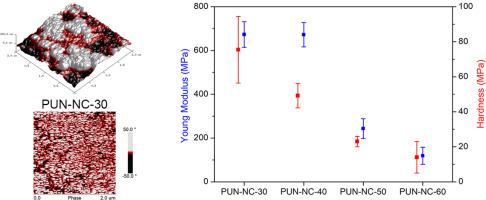Progress in Organic Coatings ( IF 6.6 ) Pub Date : 2021-12-11 , DOI: 10.1016/j.porgcoat.2021.106664 Marija V. Pergal 1 , Gordana Gojgić-Cvijović 1 , Miloš Steinhart 2 , Dragan Manojlović 3, 4 , Sanja Ostojić 5 , Lato Pezo 5 , Milena Špírková 2

|
A series of novel polyurethane network/organoclay nanocomposites (PUN-NCs) with different soft segment contents (30–60 wt%) was prepared by in situ polymerization in solution and characterized. PU network (PUN) was made from poly(dimethylsiloxane)-based macrodiol as the soft segment and 4,4′-methylenediphenyldiisocyanate and hyperbranched polyester of the third pseudo generation as the hard segment. Nanocomposites were obtained by dispersion of organically modified montmorillonite (Cloisite 30B) nanofiller (0.5 wt%). The influence of the soft segment content on the functional properties of PUN-NCs was studied by Fourier transform infrared (FTIR), small-angle and near wide-angle X-ray scattering (SWAXS), thermogravimetric analysis (TGA), dynamic mechanical thermal analyses (DMTA), differential scanning calorimetry (DSC), nanoindentation, atomic force microscopy (AFM), scanning electron microscopy (SEM), and swelling behavior, water absorption and contact angle measurements. The biodegradation process was evaluated using mixed cultures of microorganisms that originated from soil. Mechanically strong PUN-NC materials in the form of films were obtained, pointing to good dispersion and the existence of exfoliated morphology of Cloisite 30B within the PUN matrix, and the nanocomposites with the abovementioned characteristics were obtained as a function of the soft segment content. The decrease of the soft segment content induced a higher degree of phase separated microstructure, increase of Young's modulus, hardness, plasticity, storage modulus, glass transition temperature, surface free energy and swelling ability in tetrahydrofuran, but at the same time, it is responsible for the decrease of crosslinking density and hydrophobicity of PUN-NCs. By choosing adequate soft segment content, the prepared materials can potentially be designed for coating applications, such as top coating materials in environmental conditions.
中文翻译:

新型聚氨酯网络/有机粘土纳米复合材料:微观结构和物理化学性质
通过在溶液中原位聚合制备了一系列具有不同软链段含量(30-60wt%)的新型聚氨酯网络/有机粘土纳米复合材料(PUN-NCs)并对其进行了表征。PU网络(PUN)由聚(二甲基硅氧烷)基大二醇作为软链段,4,4'-亚甲基二苯基二异氰酸酯和第三代超支化聚酯作为硬链段。纳米复合材料是通过有机改性蒙脱石(Cloisite 30B)纳米填料(0.5wt%)的分散获得的。通过傅里叶变换红外(FTIR)、小角和近广角X射线散射(SWAXS)、热重分析(TGA)、动态机械热学等研究软链段含量对PUN-NCs功能特性的影响分析 (DMTA)、差示扫描量热法 (DSC)、纳米压痕、原子力显微镜 (AFM)、扫描电子显微镜 (SEM) 以及溶胀行为、吸水率和接触角测量。使用源自土壤的微生物的混合培养物来评估生物降解过程。获得了薄膜形式的机械强度 PUN-NC 材料,表明 PUN 基体中 Cloisite 30B 具有良好的分散性和剥离形态,并且获得了具有上述特性的纳米复合材料作为软链段含量的函数。软链段含量的降低导致更高程度的相分离微观结构,杨氏模量、硬度、塑性、储能模量、玻璃化转变温度、表面自由能和四氢呋喃中的溶胀能力增加,但同时,它是 PUN-NCs 交联密度和疏水性降低的原因。通过选择足够的软链段含量,制备的材料有可能被设计用于涂层应用,例如环境条件下的顶涂层材料。



























 京公网安备 11010802027423号
京公网安备 11010802027423号